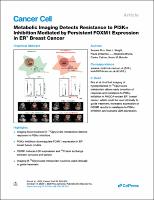| dc.contributor | Vall d'Hebron Barcelona Hospital Campus |
| dc.contributor.author | Wright, Alan J. |
| dc.contributor.author | D’Santos, Paula |
| dc.contributor.author | Hu, De-en |
| dc.contributor.author | Hesketh, Richard L. |
| dc.contributor.author | Lubling, Yaniv |
| dc.contributor.author | Antunes de Melo Oliveira, Ana Mafalda |
| dc.contributor.author | Ros, Susana |
| dc.date.accessioned | 2021-09-14T11:02:41Z |
| dc.date.available | 2021-09-14T11:02:41Z |
| dc.date.issued | 2020-10-12 |
| dc.identifier.citation | Ros S, Wright AJ, D’Santos P, Hu DE, Hesketh RL, Lubling Y, et al. Metabolic Imaging Detects Resistance to PI3Kα Inhibition Mediated by Persistent FOXM1 Expression in ER+ Breast Cancer. Cancer Cell. 2020 Oct 12;38(4):516–33. |
| dc.identifier.issn | 1878-3686 |
| dc.identifier.uri | https://hdl.handle.net/11351/6311 |
| dc.description | Inhibició de PI3K-alfa; Càncer de mama; Resposta al tractament |
| dc.description.sponsorship | This work was supported by a CRUK Programme grant (C197/A28289) and by the CRUK-EPSRC Imaging Centre (C197/A16465), and by NIH grants P30 CA008748 and R01CA190642-01, the Breast Cancer Research Foundation, and by grants from Stand Up To Cancer (Cancer Drug Combination Convergence Team), the V Foundation, and the National Science Foundation. |
| dc.language.iso | eng |
| dc.publisher | Cell Press |
| dc.relation.ispartofseries | Cancer Cell;38(4) |
| dc.rights | Attribution 4.0 International |
| dc.rights.uri | http://creativecommons.org/licenses/by/4.0/ |
| dc.source | Scientia |
| dc.subject | Mama - Càncer |
| dc.subject | Medicaments antineoplàstics - Ús terapèutic |
| dc.subject.mesh | Breast Neoplasms |
| dc.subject.mesh | Antineoplastic Combined Chemotherapy Protocols |
| dc.subject.mesh | /therapeutic use |
| dc.title | Metabolic Imaging Detects Resistance to PI3Kα Inhibition Mediated by Persistent FOXM1 Expression in ER+ Breast Cancer |
| dc.type | info:eu-repo/semantics/article |
| dc.identifier.doi | 10.1016/j.ccell.2020.08.016 |
| dc.subject.decs | neoplasias de la mama |
| dc.subject.decs | protocolos de quimioterapia antineoplásica combinada |
| dc.subject.decs | /uso terapéutico |
| dc.relation.publishversion | https://doi.org/10.1016/j.ccell.2020.08.016 |
| dc.type.version | info:eu-repo/semantics/publishedVersion |
| dc.audience | Professionals |
| dc.contributor.organismes | Institut Català de la Salut |
| dc.contributor.authoraffiliation | [Ros S, Wright AJ, D'Santos P, Hu DE, Hesketh RL, Lubling Y] Cancer Research UK Cambridge Institute and Department of Oncology, Li Ka Shing Centre, University of Cambridge, Cambridge, UK. Cancer Research UK Cambridge Cancer Centre, Cambridge, UK. [Oliveira M] Servei d’Oncologia Mèdica, Vall d’Hebron Hospital Universitari, Barcelona, Spain. Vall d’Hebron Institute of Oncology (VHIO), Barcelona, Spain |
| dc.identifier.pmid | 32976773 |
| dc.identifier.wos | 000581019300012 |
| dc.rights.accessrights | info:eu-repo/semantics/openAccess |

